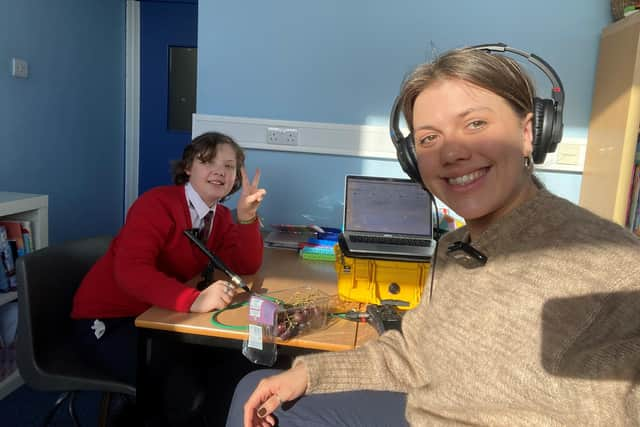The sounds of a checkered history - Freya Macleod
There is a segment of Black Watch by the National Theatre of Scotland, footage of Kilbarchan weaver Willie Meikle, and an excerpt of Powell and Pressburger’s classic I Know Where I’m Going.Placing tartan in context is crucial. A specially commissioned soundscape celebrates contemporary Gaelic identity and oral tradition, in direct relation to Tartan’s design heritage in the Highlands and Islands. It includes the voices of Gaels living in Scotland today, with their stories acting as an emotional map of past and future experiences of the Gàidhealtachd.
I recorded these interviews in February 2023. I work as a spatial designer and I’m a member of the Young Peoples Collective at V&A Dundee. Being from the Isle of Lewis, this was a method of discovering more about my own culture, while adding a place-based Gàidhlig layer to the Tartan and Identity section of the exhibition. It also includes the sounds of a Harris Tweed loom weaving black watch tartan in Uig, Lewis. The soundscape was composed by songwriter Cailean MacDonald, who also hails from Uig.
Advertisement
Hide AdAdvertisement
Hide AdThe Tartan exhibition is a radical look at the textile, but where soundscape sits in Tartan and Identity, the “radical” sits in inverted commas – it is a question to the audience and to the speakers: is it radical to be a Gael? Is wearing tartan a radical statement? Why do our identities become so entangled with place, language, and history, what relevance do these traditional Scottish practices have in the future?


The participants in the audio piece each share a conversational story in both Gaelic and English, about their connection to Tartan or being a Gael.
Katie Macinnes is 23, from Crossbost on the Isle of Lewis. She talks about her ancestral family's relationship with the clearances and that her family had to live under upturned boats for two long winters after they were cleared from a different part of the island. The croft they moved to is the same one where Katie grew up. It makes her realise that Gaels were broken down as people. She also talks about the word ‘Gael’ as a complicated idea that means many things, but she believes everyone should feel welcome to become a Gael.
From the Glasgow Gaelic School, ten-year-old Eddie Murray talks about his many nationalities – Scottish, Irish, Thai – and how that makes him feel like an interesting Gael. He explains that speaking Gaelic makes him feel quite connected to being Scottish, and maybe one day he would like to be a teacher to pass down this important heritage.
Calum George Buchanan is 51. He has young children in Uig, on the Isle of Lewis. He talks about being a Harris Tweed weaver in the rural village, where his father and grandfather were weavers before him. He explains that it was a hard way to make a living, but that it’s not all about the money. The traditional practices of weaving and crofting allow Calum to live the life he wants, and that cities could learn a lot from small communities.
Peigi MacVicar is 23 and from the Isle of Skye/North Uist. She talks about wearing a kilt to Highland dancing and says that Gaelic poetry and song can often tell us something about our history. She explains its strength to survive throughout years of being pushed down and banned. The strength of the culture is something that makes her want to remain connected to the islands, as she sings the same songs and dances the dances of her ancestors. She also says that women have been inspirational to her in the Gaelic world, and often don't get enough credit.
From Oban and Glasgow, 24-year-old Ross Christie talks about the romanticisation of Scotland- and the common misconceptions about Scottish culture that often miss the really interesting bits. Now in his 20s, he admits that the romance of wild Scotland first drew him to Gaelic, tartan and the outdoors, but now he has learned so much more. He also says that the ways that Gaels of the past viewed themselves as “custodians” of land rather than “owners” could help us solve some of the modern issues of our time; such as the climate and housing crisis.Having these indigenous sounds and voices of experience spoken alongside the objects that reflect tartan’s relationship with identities of all kinds, provides tartan with a contemporary human connection to its traditional roots.
Tartan curator Mhairi Maxwell says this project is an intrinsic part of understanding the link between tartan and Gaeldom.“Tartan has survived and revived as a badge of Scotland. Gaelic culture's living tradition is captured in the rich songs, poems and conversations in Freya’s ‘Radical Gaels’ piece. These voices celebrate and look to the future of Gaeldom, while the need to platform diverse voices, past and present, was a critical thread for us while curating Tartan.”Tartan is now open at V&A Dundee and runs until January 14, 2024. www.vam.ac.uk
Freya Macleod, spatial designer and member of the Young Peoples Collective at V&A Dundee.
Comments
Want to join the conversation? Please or to comment on this article.